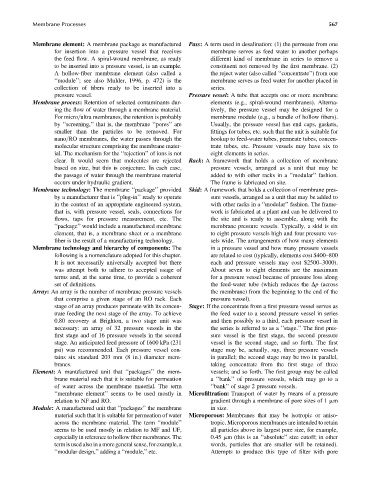Page 612 - Fundamentals of Water Treatment Unit Processes : Physical, Chemical, and Biological
P. 612
Membrane Processes 567
Membrane element: A membrane package as manufactured Pass: A term used in desalination: (1) the permeate from one
for insertion into a pressure vessel that receives membrane serves as feed water to another perhaps
the feed flow. A spiral-wound membrane, as ready different kind of membrane in series to remove a
to be inserted into a pressure vessel, is an example. constituent not removed by the first membrane. (2)
A hollow-fiber membrane element (also called a the reject water (also called ‘‘concentrate’’) from one
‘‘module’’; see also Mulder, 1996, p. 472) is the membrane serves as feed water for another placed in
collection of fibers ready to be inserted into a series.
pressure vessel. Pressure vessel: A tube that accepts one or more membrane
Membrane process: Retention of selected contaminants dur- elements (e.g., spiral-wound membranes). Alterna-
ing the flow of water through a membrane material. tively, the pressure vessel may be designed for a
For micro=ultra membranes, the retention is probably membrane module (e.g., a bundle of hollow fibers).
by ‘‘screening,’’ that is, the membrane ‘‘pores’’ are Usually, the pressure vessel has end caps, gaskets,
smaller than the particles to be removed. For fittings for tubes, etc. such that the unit is suitable for
nano=RO membranes, the water passes through the hookup to feed-water tubes, permeate tubes, concen-
molecular structure comprising the membrane mater- trate tubes, etc. Pressure vessels may have six to
ial. The mechanism for the ‘‘rejection’’ of ions is not eight elements in series.
clear. It would seem that molecules are rejected Rack: A framework that holds a collection of membrane
based on size, but this is conjecture. In each case, pressure vessels, arranged as a unit that may be
the passage of water through the membrane material added to with other racks in a ‘‘modular’’ fashion.
occurs under hydraulic gradient. The frame is fabricated on site.
Membrane technology: The membrane ‘‘package’’ provided Skid: A framework that holds a collection of membrane pres-
by a manufacturer that is ‘‘plug-in’’ ready to operate sure vessels, arranged as a unit that may be added to
in the context of an appropriate engineered system, with other racks in a ‘‘modular’’ fashion. The frame-
that is, with pressure vessel, seals, connections for work is fabricated at a plant and can be delivered to
flows, taps for pressure measurement, etc. The the site and is ready to assemble, along with the
‘‘package’’ would include a manufactured membrane membrane pressure vessels. Typically, a skid is six
element, that is, a membrane sheet or a membrane to eight pressure vessels high and four pressure ves-
fiber is the result of a manufacturing technology. sels wide. The arrangements of how many elements
Membrane technology and hierarchy of components: The in a pressure vessel and how many pressure vessels
following is a nomenclature adopted for this chapter. are related to cost (typically, elements cost $400–800
It is not necessarily universally accepted but there each and pressure vessels may cost $2500–3000).
was attempt both to adhere to accepted usage of About seven to eight elements are the maximum
terms and, at the same time, to provide a coherent for a pressure vessel because of pressure loss along
set of definitions. the feed-water tube (which reduces the Dp (across
Array: An array is the number of membrane pressure vessels the membrane) from the beginning to the end of the
that comprise a given stage of an RO rack. Each pressure vessel).
stage of an array produces permeate with its concen- Stage: If the concentrate from a first pressure vessel serves as
trate feeding the next stage of the array. To achieve the feed water to a second pressure vessel in series
0.80 recovery at Brighton, a two stage unit was and then possibly to a third, each pressure vessel in
necessary: an array of 32 pressure vessels in the the series is referred to as a ‘‘stage.’’ The first pres-
first stage and of 16 pressure vessels in the second sure vessel is the first stage, the second pressure
stage. An anticipated feed pressure of 1600 kPa (231 vessel is the second stage, and so forth. The first
psi) was recommended. Each pressure vessel con- stage may be, actually, say, three pressure vessels
tains six standard 203 mm (8 in.) diameter mem- in parallel; the second stage may be two in parallel,
branes. taking concentrate from the first stage of three
Element: A manufactured unit that ‘‘packages’’ the mem- vessels; and so forth. The first group may be called
brane material such that it is suitable for permeation a ‘‘bank’’ of pressure vessels, which may go to a
of water across the membrane material. The term ‘‘bank’’ of stage 2 pressure vessels.
‘‘membrane element’’ seems to be used mostly in Microfiltration: Transport of water by means of a pressure
relation to NF and RO. gradient through a membrane of pore sizes of 1 mm
Module: Amanufactured unit that ‘‘packages’’ the membrane in size.
material such that it is suitable for permeation of water Microporous: Membranes that may be isotropic or aniso-
across the membrane material. The term ‘‘module’’ tropic. Microporous membranes are intended to retain
seems tobeusedmostlyinrelationtoMFand UF, all particles above its largest pore size, for example,
especially in reference to hollow fiber membranes. The 0.45 mm (this is an ‘‘absolute’’ size cutoff; in other
termisusedalsoina more general sense,for example,a words, particles that are smaller will be retained).
‘‘modular design,’’ adding a ‘‘module,’’ etc. Attempts to produce this type of filter with pore

